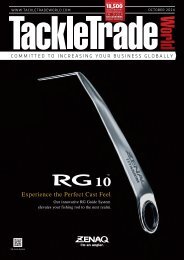Create successful ePaper yourself
Turn your PDF publications into a flip-book with our unique Google optimized e-Paper software.
SPOTLIGHT ON...<br />
LURES<br />
SPOTLIGHT ON<br />
LURES<br />
Pretty much any body of water that<br />
holds fish, anywhere in the world, can<br />
be targeted using lures. Lure fishing is<br />
probably the quickest and easiest method<br />
to get you started fishing while also<br />
promising a good success rate.<br />
At its most basic, a lure is simply<br />
a type of artificial fishing bait<br />
– essentially designed to mimic<br />
the appearance and movement of prey –<br />
to attract fish.<br />
Naturally, just like the real world<br />
of insects, smaller bait fish and other<br />
creatures, both aquatic and sometimes<br />
terrestrial, lures come in many different<br />
shapes, sizes, and colours, each designed<br />
to appeal to their chosen target.<br />
What makes them especially popular<br />
over using live bait is that they are<br />
simple and clean to use, can usually<br />
be cast further and are generally great<br />
for both catch and release angling or<br />
fishing for the pot.<br />
They can be selected to entice<br />
specific species, are easily swapped out<br />
for alternatives if one colour or pattern<br />
isn’t working and, of course, you’ll<br />
find versions and models that can be<br />
deployed in both fresh and saltwater.<br />
While lure fishing can seem<br />
quite simple, the reality is that, in the<br />
hands of an experienced angler, many<br />
lures can be devastatingly successful.<br />
Skilled anglers can impart all sorts<br />
of lifelike movement to their lures,<br />
turning a follow from a target fish into<br />
a confident strike, time after time. Of<br />
course, even greater success comes from<br />
the ability to cast them accurately, often<br />
to specific features like islands, reeds,<br />
dock pilings and the like, although fancasting<br />
can also help you cover a lot of<br />
open water very quickly and efficiently.<br />
Lure fishing is arguably the most<br />
versatile of all forms of the sport – with<br />
so many types available, ranging from<br />
hard-bodied plugs and spoons to soft<br />
plastic baits and even flies, anglers can<br />
target different species in a huge array<br />
of water conditions.<br />
Anglers have more control over the<br />
presentation of the lure, including<br />
speed, depth and action, compared to<br />
using live bait. This control can be<br />
crucial in enticing a strike from wary<br />
fish.<br />
Another often overlooked aspect to<br />
lure fishing is how visually exciting<br />
it can be! Seeing a fish strike a lure<br />
followed by the challenge of hooking<br />
and landing your target on an artificial<br />
bait can be very rewarding.<br />
Since many predatory fish hunt by a<br />
range of methods, lures have adapted to<br />
take this into account.<br />
Some are brightly coloured, some are<br />
lifelike, some are scented or have rattles<br />
or other devices inserted to make them<br />
audible too; however they all impart<br />
some form of movement, which attracts<br />
the target’s attention first and foremost.<br />
18 www.tackletradeworld.com

















